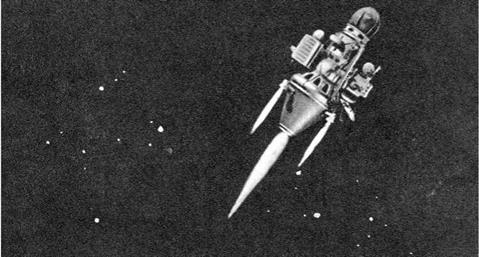RETURN TO THE MOON
To what must have been enormous relief in OKB-301, the next moon probe sailed smoothly away from Earth orbit on 9th May 1965. This date marked Victory in Europe Day, 20 years from the end of the war and hopefully this would augur well for the new probe, Luna 5. Maybe the guidance systems had at last been corrected. Nine communications sessions took place en route to the moon. During the first five, the probe radioed back its exact position as accurately as possible so that the thrust for the mid-course correction could be calculated. The fifth session issued the commands. Things began to go wrong now. The 1-100 was unable to control the probe properly and it began spinning. Ground control brought it back under control and tried again. The command instructions were issued wrongly, so the burn did not take place. By now it was too late to carry out the burn. Thankfully, Luna 5’s original path was sufficiently accurate to hit the moon, although far from the area intended, so an embarrassing repeat of the Luna 4 could be avoided. Ground control positioned the spacecraft for retrofire, aware that the spacecraft would come down about 700 km off course and that it would not be the intended direct, vertical descent but an oblique one instead. The 1-100 again failed to stabilize the probe, so retrofire did not take place. Soviet scientists in the control room listened helplessly to Luna 5’s signals as it crashed unaided on the moon at great speed, way off course. Its precise impact point has never been determined and the original Soviet announcement suggested the Sea of Clouds, a location of 30°S, 8°W being later suggested. Some subsequent analysis gave an impact point to the northwest and nearer the equator (8° 10’N, 23°26’W), but well away from the Sea of Clouds [5].
Luna 5 exploded and sent up a cloud of dust measuring 80 km wide and 225 km long. It was the second Soviet probe to impact on the moon, the first since the Second Cosmic Ship seven years earlier. The announcement of the unhappy outcome was not made until twelve hours later: whether this was in the forlorn hope that the probe might have survived, or to give time to put news management into operation, is not known.
The idea that Luna 5 had created a big impact cloud was ridiculed at the time and subsequently. The cloud was seen by observers at Rodewitsch Observatory in the German Democratic Republic until ten minutes after impact when it faded and the details given in Izvestia on 16th May. The claims were treated nowhere more seriously than in the United States, where Bellcomm Inc. was commissioned by NASA to investigate. Bellcomm’s report was done by J. S. Dohnanyi, who concluded that August that if Luna 5 impacted into a basalt surface and if the fuel of the landing rocket exploded on impact, then such a cloud was indeed possible [6].
|
Luna mid-course correction |
Luna 6 on the 8th June set off for the moon with the same promise as Luna 5. There was a sense of apprehension as the mid-course manoeuvre approached. Although the rocket switched on correctly, it would not turn off! The engine continued to blast away remorselessly, sending Luna 6 away in the opposite direction. It missed the moon by no fewer than 160,935 km, what must have been a record. Trying to salvage something from another disappointment, ground control commanded a separation of the lander and inflation of the airbags, a manoeuvre that apparently worked.











